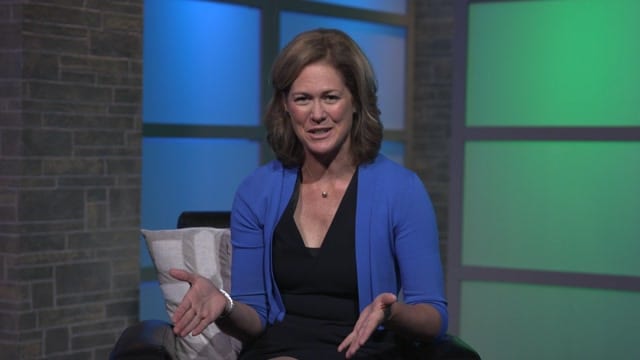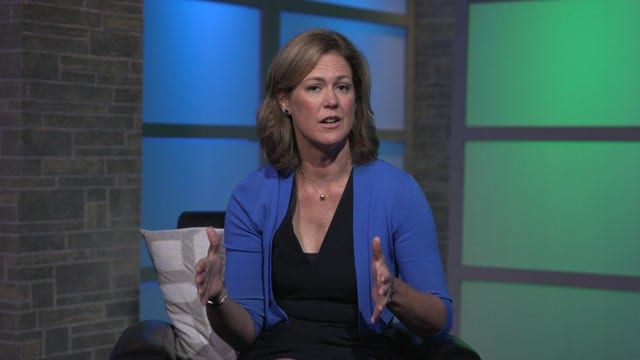
Conflict often stirs up complex and contradictory emotions. In this clip, Sheila Heen helps you learn how to identify the multiple feelings you may be having in order to move forward in your difficult conversations.

Conflict often stirs up complex and contradictory emotions. In this clip, Sheila Heen helps you learn how to identify the multiple feelings you may be having in order to move forward in your difficult conversations.

Conflict often threatens aspects of our core self-identity. In this clip, Sheila Heen explores the challenges of black-and-white thinking and how being able to embrace the ‘and’ will allow us to shift to a learning stance.

Danielle Strickland describes two practices you can use to empower the people around you.

John C. Maxwell teaches how you will be inspired when you get around leaders who lead bigger organizations.

When you are meeting with a leader who inspires you, John C. Maxwell identifies two key ways to prepare for that conversation.

Grit can change either by culture, or by what we learn through experience.

Our friend Craig Groeschel released a brand-new book this week called, Hope in the Dark: Believing God is Good When Life Is Not. Groeschel explores the story of the father who brought his demon-possessed son to Jesus, saying, “I believe! Help my unbelief!” In the man’s sincere plea, Jesus heard the tension in the man’s battle-scarred heart. Read the excerpt below for a sneak peek into this brand-new content from Craig Groeschel!
Not that I’m really old—at least, not yet—but it seems like every time I go to the store, I forget something unless it’s written down. Yeah, I’m that guy jogging from the checkout lane back to aisle 12 for a bottle of ketchup. Even if it’s only two or three items, unless it’s on paper or the notepad app on my phone, I seem to lose track of whatever Amy asked me to buy. Was it chocolate ice cream with cherries and nuts or chocolate chip ice cream with nuts and cherries? You’d think it wouldn’t make a difference, but it does.
So, I’ve learned to write it down.
When God says something to you, record it, because your spiritual enemy is an expert at stealing the seeds of truth that God wants to plant. You might keep a notebook just for such impressions or jot them down in your daily journal. God may show you something, and if you don’t write it down or make some kind of record that you can refer back to, it’s way too easy to forget what he showed you.
When God says something to you, record it, because your spiritual enemy is an expert at stealing the seeds of truth that God wants to plant.
I can’t tell you how many times this has happened to me. I’ll be wrestling with something I don’t understand and praying about it. “God, are you there? What’s going on? What do you want me to do in this situation? What are you up to?”
Then I often feel like God shows me something, provides direction or speaks to my heart. I’ve learned to write it down, because inevitably, a few days later, I’ll be thinking about it again, and I might talk myself out of it. “Well, I don’t know. Maybe it was that late-night snack. Just some divinely inspired indigestion.” So, I begin to doubt what I knew with certainty only a couple of days ago. My awareness of God’s message to me seems to vanish unless I write it down.
When I record it, though, it becomes a spiritual anchor that tethers me to God and to the consistency of his promises. “Yes, I believe that God has spoken.” And better than that, I have a reference point that I can return to; it doesn’t depend on my mood or what I had to eat the night before.
When you develop the discipline of writing down what God shows you and what you’re praying about, you might be shocked over a few years at all that God does. George Mueller was a well-known evangelist who lived in the 1800s. One day, his heart broke when he saw hundreds of homeless children fending for themselves on the streets of Bristol in England.
With almost no money to his name, he decided to start an orphanage, and over the next 60 years, Mr. Mueller helped care for more than ten thousand orphans. All throughout his ministry, he kept a record of his prayers in a journal that ultimately filled more than three thousand pages. He recorded how one night there was no food to give the children the next morning at breakfast, so he begged God to do something.
Early the next morning, a local baker knocked at his door. When Mueller answered, the baker told him he hadn’t been able to sleep the night before, so he had gotten up and baked three batches of bread, which he had brought for them. Another time, a milk truck just “happened” to break down in front of the orphanage on the exact day they had no milk for the children.
Since the milk would have spoiled in the heat, the driver gave it to the orphans. All in all, Mr. Mueller recorded more than thirty thousand direct answers to his prayers. Just imagine how this built his faith, as he saw God’s faithfulness laid out before him again and again in black and white.
If you are anything like me, journaling is a challenge. I can’t count how many years I committed to journal daily, only to forget and quit by the middle of January. Finally, several years ago, I had a breakthrough. Someone gave me a five-year journal that has helped my relationship with God more than I can describe. Instead of pressuring me to write a couple pages a day about my feelings, prayer requests and important events, this journal is way simpler.
Each page represents one day, but will eventually cover five years. For example, on January 1, there are five lines to write on for the current year. Then just below those five lines are five more lines, for January 1 next year. And so on. So essentially you are writing only a fifth of a page each day. And over a five-year period, you get to see what happened each year on that same day. The best part for me? Instead of writing pages, I have only a few lines to fill in, making it easy to continue.
During the first year, I found it easy and somewhat meaningful. The daily discipline helped me keep God at the front of my mind as I recorded something I was praying about each day. But during year 2, I noticed something that really impacted me.
When I returned to the same day from the previous year to begin the next one, suddenly I realized how many things that had weighed on me then were completely handled now. Problems worked out. Challenges met. Prayers answered. Concern with one of my kids had been resolved and was no longer even on my radar. Losing a valuable staff member had seemed like a big setback, but a year later we had someone in place who was even more effective. A challenge with a friendship had course-corrected, and we’re closer now than ever before.
Once I stopped obsessing over my present problems and started looking back to past ones, I could see how God was faithful in ways I might have missed otherwise.
Journaling daily with a glimpse back to the previous year helped me see a bigger picture. Once I stopped obsessing over my present problems and started looking back to past ones, I could see how God was faithful in ways I might have missed otherwise. And the power of this realization came from one simple discipline: writing it down.
Maybe you’re thinking, “Come on, Craig! I get what you’re saying, but I’m just not much of a writer. It’s a great idea, but do you really expect me to get on my laptop—or even crazier, take out paper and pen—and write down what I think God is saying to me?”
Yes.
Absolutely.
You got it.
When you write down what God tells you, you can use it not only as an anchor, but also as a litmus test. Every time you refer to it, you can compare it with what you see happening around you, and it can help guide you in your decisions. Be patient, and be consistent. It may take years before what he tells you comes to pass, as it did with the vision we had for our church. But if God makes you a promise, it will happen.
It’s simply a matter of when.
Order your copy of, “Hope in the Dark,” by Craig Groeschel here.
Taken from Hope in the Dark by Craig Groeschel. Copyright © 2018 by Craig Groeschel. Used by permission of Zondervan. www.zondervan.com.

Liz Bohannon, entrepreneur and founder of Sseko Designs, questions if faith-centered leaders are focusing on the right conversations to help women find their callings.

“My wife and I love running races,” says Steve Coburn, a Detective Sergeant with the Ontario Provincial Police in Ontario, Canada. “We’re always participating in different races in our community.” While participating in a charity race in the fall of 2013, Steve was thinking about the beneficiaries of the race and about what his church did to raise money for community needs. “Something hit me. I heard a whisper from God saying ‘we can do this’.”
I left with the idea that love is action, and you just have to move forward and ‘land the plane.
Steve had just returned from his first Global Leadership Summit where he heard Bob Goff speak on the concept of Love Does. “I left with the idea that love is action, and you just have to move forward and ‘land the plane’”, says Steve.
Just three months later, a small group of people gathered at Compass Community Church in Orangeville, Ontario to put Bob’s message into action and make God’s whisper a reality. Bonded by Steve’s conviction, the Compass Run for Food Team was forged and planning began.
Organizing and hosting a charity race is a huge event that requires the coordination of many volunteers, runners, sponsors and beneficiaries to make sure needs are met and goals are reached. Rational people hesitated to launch the event on such a large scale in its first year. The team pressed on with the conviction that God wanted them to stay true to the original vision and ‘land the plane’.
In June 2014, the first Compass Run for Food raised over CDN 10,000 (USD 7,560) for the local food bank. In 2017, the team expanded the list of beneficiaries to include local school breakfast programs. “I was training for a race, and having hamstring problems,” says Steve. “My physiotherapist told me about all the needs in the schools, and I realized we could use this race to benefit the educational community.”
Through his years of service as a police officer, Steve was well aware of the relationship between positive community support and crime reduction. For school boards, collaborating with a church, even for a good cause, can be politically sensitive. Steve learned that “when we can provide for our schools with no strings attached, the schools are open to embracing the church. We’re also involved with the local corporate community, and people from various sectors are coming together to meet the needs of our community.”
In five years, the annual run has raised $126,000 to feed the community!
Going to the Summit has helped me put so many things into perspective, and I’m a better leader at work, in my church and in my community.
Steve has learned a lot through his experience. In his early years as a young police officer, Steve encountered leaders that said, “If you don’t do what I say, you’re going to count paper clips.” Police leaders have changed significantly since then but the Summit, and his subsequent call to action, further enriched Steve’s own understanding. He now defines a leader ‘as one who serves’. “Working in a church in a volunteer role is a whole different dynamic, and it’s changed me,” says Steve. “Going to the Summit has helped me put so many things into perspective, and I’m a better leader at work, in my church and in my community.”
If Steve hadn’t been ignited at the Summit to take action in this way, he admits he would be doing nothing. “I would be sitting on my couch – and yes, organizing this race is a lot of work, but it’s life giving!” says Steve. “We’re igniting the church in a new way to serve the community. Five years ago, when we were in that first meeting, we wouldn’t have imagined we would be here now. We don’t know where we’re going, or where God is leading this, but there’s a community buy-in factor. Every year, we go into the unknown, and we keep raising the bar. God is on the move!”

Leadership requires us to invest in our people–communicate things to them, teach them, facilitate their success, etc. One of the best ways that I’ve found to do this in a formal way is through my one-on-one meetings. There are some structural things that help me maximize the value of these one-on-ones for me:
For some employees, this is weekly. For others it is bi-weekly or even once a month. But, they need to be scheduled regularly and predictably. In other words, if they’re weekly, plan them at the same time and on the same day each week. The frequency of the one-on-ones should be based on performance and scope of work. If an employee does a complex job that brings new things each week, it might make sense to meet weekly. if an employee repeats tasks each week, it may make sense to meet only once a month. And if the employee is doing an excellent job, the meeting may need to be less frequent.
One-on-ones are a great time to ask your employee(s) how they’re doing. In fact, I try to make this the first thing we talk about. If the meetings are only about work, then we miss a great opportunity to get to know our employees better and to find out if there are outside pressures that may impact their jobs. Plus, it lets the employee know you care about them and they’re not just a worker, but someone that you value.
Let the employee know you care about them and they’re not just a worker, but someone that you value.
I always allow the employee to start with agenda items that they have come to the meeting with. It seems somewhat counterintuitive because we often want to make sure that our agenda items get covered first, but I’ve found this puts the employee in the driver seat and allows them to set the tone. Often, they will cover many of the things that I intended to cover anyway. This is also another way to help them understand that they are important and what concerns/ideas/questions they have are a priority to you.
I use a software program called Wunderlist as my shared to-do list with each of my employees. This allows me to add things as I see them and then review them with the employee as we meet during these one-on-ones. It is also the system that I add to as we discuss things and recognize things that need to be done. This will help you get the meeting started well and help you feel confident that goals will be accomplished.
I’ve heard it said that you have to inspect what you expect. If you assign a task, you should follow up to make sure that it gets done. For some employees, this means simply checking the shared to-do list to see that it’s done. For others, this means physically going and checking in on the items to ensure their completion. But, regardless you must use these one-on-ones as a time to follow up on previous tasks and items.
Use your one-on-one time for the two of you to get on the same page—vision, tasks, purpose, and outcomes.
As things are added to a to-do list or tasks are shared over email or text, it can be difficult for an employee to see things as you see them or to fully align with your vision for the organization. One-on-ones are good times to take a walk to a place in the building so you can share vision, or a time for you to pull up a website and show them your expectations about a project, and so on. Use it as a time for the two of you to get on the same page—vision, tasks, purpose, outcomes, etc.
The more you’re able to invest in your people in these ways, the better relationships you will have and the more productive your team will be!
“We welcome and encourage comments on this site. There may be some instances where comments will need to be edited or removed, such as:
If you have any questions on the commenting policy, please let us know at heretoserve@globalleadership.org”
Recent Comments